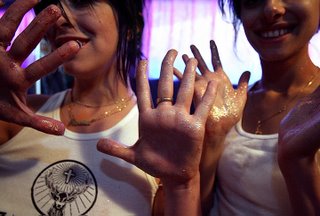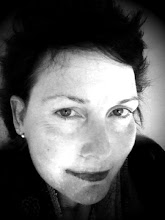Conversations about photography and opinion can be thought provoking, and I feel it is always good to ask ourselves questions that keep us in check and to remind us as photojournalists why, how, when and where we take our images... After viewing the beautifuly stylized photos taken by Greenberg, they are but a moment in time, an art concept, which has nothing to do with photojournalism. Yet still, the conversation is facinating and I wanted to post this for that reason.
The question is.... for all you photogs out there... would you take these images? How would you take these images? And why?
photography
Exploit and Click
The fuss over the photographer who makes kids cry.
By Jim Lewis
Posted Friday, July 7, 2006, at 6:35 PM ET
Like many people, I dislike having my picture taken, and the fact that I love to look at photography, to think about it, and sometimes to write about it, has done little to leaven my antipathy toward participating in it. Having a camera pointed at me makes me self-conscious, a feeling I do my best to avoid; and it prick! ! s my vanity. (I used to tell myself I was simply unphotogenic, but in time I came to realize that, no, in fact I just look like that.) Moreover, I always wind up feeling slightly violated: My countenance is among my most intimate possessions, and when a photographer makes off with an image of it I feel like I've been fleeced. Anthropologists have described isolated tribes who would not allow themselves to be photographed by Western visitors because they were convinced that some part of their soul was being stolen. There is something to be said for such a belief.
Exploitation is photography's true métier: I take that to be a fact, though not such a damning one as it may appear to be. There are other professions, after all, that traffic in similar kinds of advantage-taking (psychoanalysis is one; journalism is another), and exploitation, like anything else, can be well or badly done. Some photographers negotiate it nimbly, with a kind of moral intelligence, and the art th! ! ey make is brilliant and enlightening; and some are clums! y or cra ss. Which brings me to the work of Jill Greenberg and the quarrels that have sprung up around it in the past few weeks.
Greenberg is an L.A.-based photographer whose work, judging from her Web site, the all-too-aptly named www.manipulator.com, has generally been commercial and editorial: ads for Target, portraits of celebrities, that sort of thing. But she also has a small art career, showing more conceptual work in galleries, and she has an exhibit up now at the Paul Kopeikin Gallery on Wilshire Boulevard. The show is titled End Times, and it consists of a few dozen large photographs of infants and toddlers throwing tantrums: sobbing, red-faced, staring furiously. Fair enough. But they're not meant to be read as mere baby pictures; they're meant to be a statement. As Greenberg herself explains in the gallery's press rel! ! ease, "The first little boy I shot, Liam, suddenly became hysterically upset. It reminded me of helplessness and anger I feel about our current political and social situation." "As a parent," she continues, "I have to reckon with the knowledge that our children will suffer for the mistakes our government is making. Their pain is a precursor of what is to come."
This is the sort of art that makes one groan and roll one's eyes. It's political in the worst way: literal-minded, preachy as a bumper sticker, and, well, infantile. Moreover, the pictures themselves don't look very interesting (for one thing, Greenberg seems to think that size—the photos are 42 inches by 50 inches—is a substitute for power). But lots of people make bad art without inspiring the kind of fury that Greenberg drew down upon herself. Her mistake was not in her meaning, but in her method.
It turns out that Greenberg doesn't just hang around her studio waiting for one of her toddler subjects t! ! o melt down: She induces the tantrum, by, say, giving the! child a lollipop, and then suddenly taking it away. When a photography enthusiast who goes by the pseudonym of Thomas Hawk discovered as much, he pilloried Greenberg on his blog, in a post that can be summarized by its headline: Jill Greenberg is a Sick Woman Who Should Be Arrested and Charged With Child Abuse. The post generated a few hundred comments, and the discussion spread to Flickr, and then to other blogs, and then finally to BoingBoing. Most of those who weighed in came down on Hawk's side. Greenberg responded in an interview on PopPhoto.com.
It looks like what's going on here is the standard "can good art be made by bad people" debate, but to the extent that that's so, it's uninteresting. As Faulkner once said, "If a w! ! riter has to rob his mother, he will not hesitate; the 'Ode on a Grecian Urn' is worth any number of old ladies." But Greenberg isn't Keats, and bad art neither deserves nor receives the kind of moral pass that Faulkner was endorsing. An asshole who makes great art is an asshole who makes great art; but an asshole who makes lousy art is just an asshole.
On the other hand, Greenberg isn't Leni Riefenstahl, either. Small children, as she points out in the PopPhoto interview, often have tantrums, and they usually blow over quickly, and are just as quickly forgotten. To provoke tears in order to take a picture is objectionable, and worthy of some condemnation. But it's not as if she beat them with a belt because she wanted to photograph their bruises. On this front, it seems to me, Greenberg was wrong, and Hawk overreacted, and there isn't much more to be said.
But an insight can be sifted out of Greenberg's peccancy and Hawk's cant. Photography tends to magnify and di! ! stort both deeds and misdeeds—more so than other art fo! rms, and in fact more than almost any activity I can think of. The specter of exploitation hovers over it, and it's this, I think, that accounts for Hawk's disproportionate outrage. If Greenberg were making infants weep in the service of a psychological experiment, one might feel uneasy, but the dismay would no doubt be tempered by one's sense that a greater good was to come of it. If she were doing it because she wanted to, say, draw them, or write poems about them, many people might still find it objectionable, but not, I don't think, to quite the same degree. Indeed, if she were doing it just for the hell of it, we would consider her cruel and culpable; but the fact that she made them cry so that she could take their pictures somehow makes it worse.
The point becomes clearer, or at any rate starker, by comparison with pornography. In most states, the age of consent is 16 or 17, but federal law stipulates that you can only be photographed having sex if you're 18 or older. Two ! ! 17-year-olds can copulate to their hearts' content, and their friends can watch: However creepy it may be, no laws would be broken. But they can't be photographed in the act, nor can anyone, of any age, so much as look at such a photo. The picture has a legal status quite different from the thing it pictures.
This is as it should be, for many reasons; but one of them is simply that photography is, in its essence, a form of predation, and its being so transforms the meaning of the scenes it shows. The power of the photographer over his or her subject is immense, and not just because one can manipulate the other, or even because one acquires and owns an image of the other. A photograph is, as the vernacular has it, something you "take," but the taking isn't simply material: It's metaphysical, and it's moral (I would say it's spiritual, if the word didn't seem vapid).
Exploitation lies at the root of every interaction between a photographer and a human subject, and ev! ! ery photographer worth a damn knows this. It is unavoidab! le, it i s intrinsic to the very act taking pictures, and the most sophisticated photographers work their understanding of it into their practice, in various subtle ways. I've watched dozens of them at work, and each has a different method: Some bond with their subjects, some boss them around, some flirt and seduce, some ignore, some distract, and some just watch. But with the best of them you can see something in their eyes, and in their work, that proves their trustworthiness and creates a kind of complicity. Jill Greenberg is decidedly not one of the best, but her clumsiness inadvertently reveals a fundamental truth: Taking a picture is a deep and ethically complex thing to do, and everyone who engages in it is compromised, right from the start.
I don't mean this as a condemnation of photography. On the contrary, I love the medium, and it fascinates me endlessly, precisely because it's so freighted with the problem of power and responsibility. It is born in a bed of plunder an! ! d abuse; but in the right hands it can end in beauty, and how we get from one to the other is as profound a grace as any art can manifest.
Jim Lewis is the author of three novels, most recently, The King Is Dead.
Article URL: http://www.slate.com/id/2145277/
Copyright 2006 Washingtonpost.Newsweek Interactive Co. LLC
 My job is amazing, challenging and interesting. We have to adapt to all kinds of situations, never knowing just what the outcome will be.
My job is amazing, challenging and interesting. We have to adapt to all kinds of situations, never knowing just what the outcome will be.












